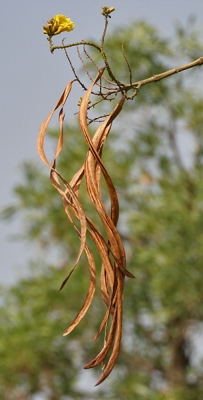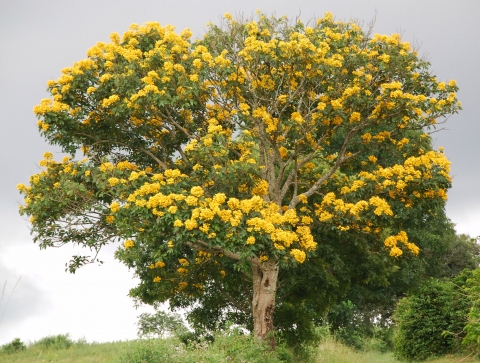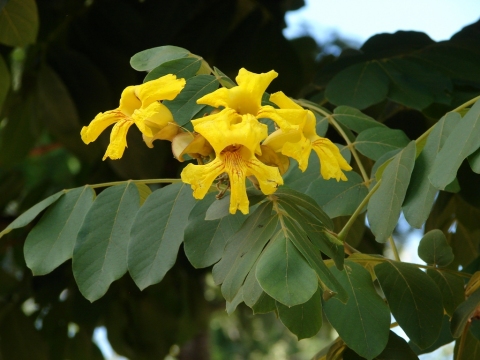(Benth.) K.Schum., Bignoniaceae

|

|

|

|

|
|
(Benth.) K.Schum., Bignoniaceae |
|
Present on Pacific Islands? yes
Primarily a threat at high elevations? no
Risk assessment results: High risk; score: 5+second screening (Hawaii-Pacific Weed Risk Assessment for Markhamia lutea)
Other Latin names: Dolichandrone hildebrandtii Baker; Dolichandrone lutea Benth. & Hook. f.; Dolichandrone platycalyx Baker; Markhamia hildebrandtii (Baker) Sprague; Markhamia platycalyx (Baker) Sprague; Spathodea lutea Benth.
Common name(s): [more details]
|
English: markhamia, siala |
|
Swahili: mgambo, mtalawanda, siala |
Habit: tree
Description: Brief ID summary: Grows up to 40 feet; compound leaves, thin and wavy; flowers are bright yellow with 5 frilly lobes and throat striped with orange-red. (Plant Pono) "Evergreen small to medium-sized tree up to 25(30) m tall; bole often short but sometimes branchless for up to 20 m, up to 70 cm in diameter, older trees often fluted at base; bark surface finely cracked, pale brown to reddish brown or dark grey, inner bark fibrous, yellowish; crown usually narrow, irregular; branches with numerous lenticels, twigs slightly hairy. Leaves opposite, imparipinnately compound, up to 35 cm long, with (2)36 pairs of leaflets; stipules absent, but pseudostipules present, rounded, 23 cm in diameter; petiole 612 cm long; petiolules up to 0.5(1) cm long; leaflets opposite, elliptical to obovate, 4.521 cm Χ 49 cm, cuneate to rounded at base, acuminate at apex, papery, covered with small scales, pinnately veined with up to 15 pairs of lateral veins. Inflorescence a terminal panicle up to 20 cm long and wide. Flowers bisexual, zygomorphic, large and showy, scented; pedicel c. 0.5 cm long; calyx spathe-shaped, 22.5(3) cm long, covered with small scales; corolla golden yellow, with brownish purple or red veins or spots at the throat, with tube (2)34.5 cm long and 2-lipped and 5-lobed limb, lobes (1)1.52.5 cm long and wide, glandular; stamens 4, 23 cm long, 2 longer and 2 shorter, inserted on the corolla tube, included; disk 5-lobed; ovary superior, oblong, 0.51 cm long, 2-celled, style 22.5 cm long. Fruit a linear, curved capsule 3580 cm Χ 12 cm, flattened, covered with small scales, dehiscing with 2 valves, many-seeded. Seeds irregularly rectangular, with 2 lateral wings, 0.51 cm Χ 2.53.5 cm including wings, yellow-white. Seedling with epigeal germination." (PROTA)
"Markhamia lutea. . .is a tree with pinnately compound leaves, broadly bell-shaped yellow flowers with red lines inside the tube, incompletely spathelike calyxes, and leafy false stipules." (A Tropical Garden Flora, p. 191)
Habitat/ecology: "Markhamia lutea occurs naturally in evergreen forest, riverine forest, forest edges and wooded savanna, at 6002400 m altitude. The mean annual rainfall in the area of distribution is 7002000 mm, with 35 dry months. Trees are quite drought resistant, and do not tolerate waterlogging. Markhamia lutea prefers deep, well-drained red loamy soils, but also grows on gravelly loams, sandy soils and acidic clay soils as long as these are well drained." (PROTA)
"M[arkhamia]. lutea is common in the lake basins and highland areas of eastern Africa. The tree is drought resistant but cannot withstand waterlogging." (World Agroforestry)
"[Markhamia lutea] is native to tropical Africa, where it is a fast-growing, second-growth tree. . . ." (A Tropical Garden Flora, p. 191)
"Planted trees grow fast, up to 2 m per year. In an experiment in Burundi, the wood volume 3.5 years after planting 5-months-old seedlings of Markhamia lutea at a spacing of 4 m Χ 8 m was 0.8 m³/ha. In a 26-years-old plantation in DR Congo, planted at a spacing of 2 m Χ 2 m, the mean height of trees was 25 m with boles up to 16 m long and up to 33 cm in diameter. Trees reached 30 m tall after 60 years. Markhamia lutea develops a very large root system. Under favourable conditions, young trees may start flowering when only 3 m tall. In western Kenya trees flower in August--September, in eastern Kenya in December--January. Fruits ripen about 6 months after flowering. The winged seeds are dispersed by wind." (PROTA)
Propagation: In Hawaii, "[c]ultivated specimens are often seen fruiting heavily, and with its wind-dispersed seeds, this species has been suggested. . .to become an eradication target." (HBS Records, p. 19)
"Markhamia lutea often colonizes gaps in the forest, forest edges and formerly cultivated land. Seedlings can be found in full sun or light shade, but do not tolerate long dry periods. Ripe fruits, which are greyish, are collected from the tree before they open. They are dried to collect the seeds. There are about 75,000 seeds per kg. Seeds are usually sown when they are fresh. Fresh seed has a germination rate of 3060% in 34 weeks. . . . Propagation by cuttings is sometimes practised, using either small cuttings, or long ones 11.5 m long and 36 cm in diameter cut from coppice shoots. Wildlings are also collected for planting. Planting experiments in Ethiopia showed 98% survival of Markhamia lutea 4 years after planting." (PROTA)
"Propagates from seed
Abundant fruits
Seeds are wind dispersed and have high rate of viability
Trees coppices [sic] after cutting" (Plant Pono)
For cultivation: seeds (Gardentia)
Native range: Africa: "Markhamia lutea occurs from Cτte dIvoire east to Kenya and south to DR Congo and Tanzania," including Kenya, Uganda and Tanzania. (PROTA)
"[Markhamia lutea] is native to tropical Africa, where it is a fast-growing, second-growth tree. . . ." (A Tropical Garden Flora, p. 191)
Impacts and invaded habitats: Markhamia lutea is naturalized on Hawaii Island, in parts of Europe, and in the Himalayas; it produces abundant fruits and propagates from highly viable, wind-dispersed seeds. Trees coppice after cutting; roots compete for nutrients with agroforestry crops; and the species forms dense shade, preventing regeneration of "more desirable" species. (Plant Pono)
"Fast growing tree with the ability to spread into disturbed forests; produces viable wind dispersed seeds within two years." (BIISC)
Presence:
| Pacific | |||
|
Country/Terr./St. & Island group |
Location |
Cited status &
Cited as invasive & Cited as cultivated & Cited as aboriginal introduction? |
Reference &
Comments |
|
State of Hawaii
Hawaiian Islands |
Hawai‘i (Big) Island |
introduced
cultivated |
Parker, J. L./Parsons, B. (2016) (p. 19)
new naturalized record 06 January 2014; document accessed 20171218 "Cultivated specimens are often seen fruiting heavily, and with its wind-dispersed seeds, this species has been suggested to the committee to become an eradication target." |
|
State of Hawaii
Hawaiian Islands |
Hawai‘i (Big) Island |
introduced
invasive cultivated |
Plant Pono (year unknown)
Propagates from seed; Abundant fruits; Seeds are wind dispersed and have high rate of viability Trees coppices after cutting |
|
State of Hawaii
Hawaiian Islands |
O‘ahu Island | Consortium of Pacific Herbaria (2018) | |
| Pacific Rim | |||
|
Country/Terr./St. & Island group |
Location |
Cited status &
Cited as invasive & Cited as cultivated & Cited as aboriginal introduction? |
Reference &
Comments |
|
Asia
Asia |
Himalayas |
introduced
invasive |
Plant Pono (year unknown)
"Naturalized... [in] the Himalayas" Propagates from seed; Abundant fruits; Seeds are wind dispersed and have high rate of viability Trees coppices after cutting |
| Also reported from | |||
|
Country/Terr./St. & Island group |
Location |
Cited status &
Cited as invasive & Cited as cultivated & Cited as aboriginal introduction? |
Reference &
Comments |
|
Africa
Africa |
Ethiopia |
introduced
cultivated |
PROTA (2017)
"It is commonly planted in some regions within its distribution area, particularly in Kenya, Uganda and Tanzania, and sometimes elsewhere, e.g. in Ethiopia and in the southern parts of the United States." |
|
Europe
Europe |
Europe |
introduced
invasive |
Plant Pono (year unknown)
"naturalized in parts of Europe" Propagates from seed; Abundant fruits; Seeds are wind dispersed and have high rate of viability Trees coppices after cutting |
|
India
India |
India (Republic of) |
introduced
cultivated |
Sarkar, Baishakhi/Bera, Subir/Das, A. P. (2015) (pp. 535-537)
"During a floristic exploration in the Dooars region of West Bengal, an interesting tree of Bignoniaceae was spotted in the Khuntimari forest, under the Jalpaiguri Forest Division. ...the plant was uthenticated as Markhamia lutea (Bentham) K. Schumann. ... This tree is indigenous to Kenya and in India it is planted as a road side tree in Bangalore only [Nagendra & Gopal 2011; ww.indiabiodiversity.org]. Earlier it has neither being collected nor was reported from West Bengal or even from the eastern part of India." (p. 535) "It is difficult to explain the presence of Markhamia lutea within the natural forests of Dooars. The location is not showing any sign of modified vegetation. Arrival of its seeds/ propagules from some remote area is also difficult to explain. However, the forest department establishments in this area are quite old. It is possible that previously the species was introduced in the area, probably as an ornamental, which was escaped into the nature in due course. But, the presence of only two stands of the species is again confusing as on escape the species should have increased its population in the mean time!" (p. 537) |
|
United States (continental except west coast)
United States (other states) |
United States (other states) |
introduced
cultivated |
PROTA (2017)
"It is commonly planted in some regions within its distribution area, particularly in Kenya, Uganda and Tanzania, and sometimes elsewhere, e.g. in Ethiopia and in the southern parts of the United States." |
|
United States (continental except west coast)
United States (other states) |
USA (Florida) |
introduced
cultivated |
Wunderlin, R. P./Hansen, B. F./Franck, A. R./Essig, F. B. (2018) |
Comments: In Hawaii (A Tropical Garden Flora, pp. 180 & 191)
New naturalized record on the Big Island of Hawaii reported based on a 2014 specimen. "In Hawaii, Nile tulip [PIER ed.: Markhamia lutea] has been observed spreading in two locations in the Puna and North Kona districts. Cultivated specimens are often seen fruiting heavily, and with its wind-dispersed seeds, this species has been suggested to the committee to become an eradication target." (HBS Records, p. 19)
"Some of them have been occasionally found as escapes, on forest margins and roadsides" (Flora Zambesiaca)
" It is commonly planted in some regions within its distribution area, particularly in Kenya, Uganda and Tanzania, and sometimes elsewhere, e.g. in Ethiopia and in the southern parts of the United States." (PROTA)
Control: If you know of control methods for Markhamia lutea, please let us know.